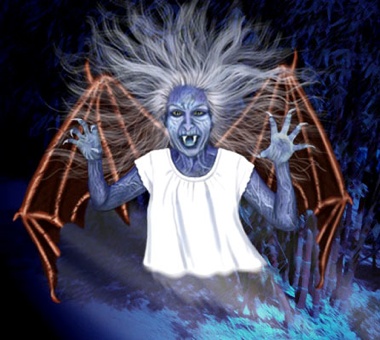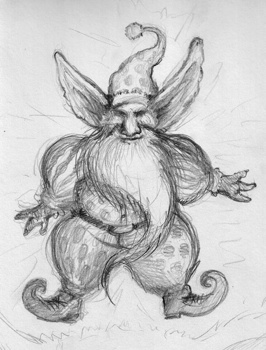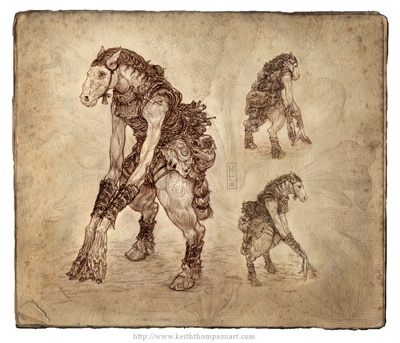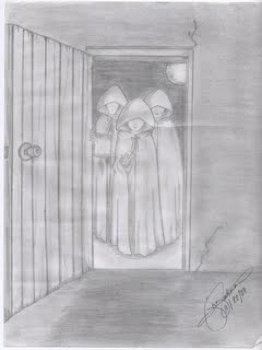The aswang is probably the most common of Filipino monsters since there are so many different kinds. In general, they are shape shifters who are human by day and then at night turn into a dog, a pig, a bat, cat, snake… the type of animal depends on the regional lore. They break into funeral homes and steal recent corpses. They are also known to enter homes to drink human blood and can turn people into aswang by tricking the human to bite them in return. The aswang are especially hungry for human fetus so some of the more superstitious stories include neighborhoods patrols set up in front of the home of a pregnant woman to protect her from wandering stray animals in case they are the aswang in disguise.
The Matruculan is one of many Filipino creatures who attack pregnant women. This particular creature first impregnates a virgin before coming back later to kill the woman and eat the fetus (although some stories say that both mom and baby are eaten). Some stories claim that the woman is not a virgin but rather married and already pregnant. To protect the mother and child, the husband must swing a balisong (pictured above), or butterfly knife, above the woman’s belly while she is in labor. This leads one to wonder: which is scarier, an invisible mythological creature, or the father of your unborn child brandishing a knife above your abdomen?
These are hairy giants with glowing eyes and a cigar that never burns out. They can usually be found sitting atop of trees waiting for nightfall to scare naughty children who are outside of their homes late at night. The Kapre is a unique Filipino monster because he doesn’t steal fetuses, eat people or cut them up. The Kapre simply enjoys scaring children… and I suppose laughing at them for being scared. Some stories claim they are actually very friendly beings who can grant wishes if you find their magical white stone. One can assume a Kapre is nearby when trees sway while there is no breeze or you see faint smoke from high above, probably from the Kapre‘s cigar..
These are tiny human-like creatures that live underground. There are two main types of Duwende: the duwende puti who are supposedly kind creatures who bring about good luck, or the duwende itim who are mean folk that like to play pranks on humans. They generally keep to themselves and only interact with humans when their homes are disturbed. For example, a kindly farmer who takes care of his plot may be rewarded by the duwende puti with a greater abundance of crops than usual. However, someone who kicks an anthill on or near the home of a duwendi itim will be punished with a myriad of ailments from twisted mouth to swollen testicles. The best way to avoid Duwende of any kind is to say “Tabi-tabi po” aloud before entering what might be their space.
The tiyanak is similar to the Greek mythological siren in that it lures its prey with its voice. A person hears a baby cry from deep in the woods and then follows the sound to rescue the baby. Some stories say the person wanders aimlessly in search for the baby and becomes hopelessly lost. Other stories claim that the person eventually finds a baby in the middle of the woods. When it is picked up, the baby then shape-shifts into a monster with large, sharp teeth. It then eats the person and transforms back to a baby to await its next victim. With either version, the story ends with “… and he was never found again.”
Depending on region and storyteller, the sigbin resembles either a hornless goat, a reptilian crow, or something vaguely along the lines of the Chupacabra. What is most common with all accounts is that its head hangs between its forelegs which are much shorter than its hindlegs. Whether because of physiology or because it makes the sigbin seem scarier, it is also known to crabwalk backwards. The sigbin also has a long whip-like tail that emit’s a foul stench and two grasshopper-like legs on its neck that enable it to jump far distances. They wander around at night in search of children to devour but they keep the hearts to make amulets. Most stories and sightings originate from the Cebu region. However, although it is some distance away, in 2005 scientists in Borneo discovered a “cat-fox-like carnivore” with hind legs longer than forelegs giving it an awkward gait and physical appearance that somewhat fits many of the descriptions of the sigbin (e.g. long tail, short forearms, can jump far distances, carnivorous). No conclusive evidence has been found yet to link the two together. [Image Source]
The tikbalang is described as having the head of a horse, the body of a man and the hooves of a horse where human feet would be. In northern regions, the tikbalang is considered a nuisance but generally harmless. They enjoy disorienting weary travelers and making them imagine things that don’t exist. Travelers can easily stop the pranks by turning their own shirt inside out and asking the tikbalang to stop bothering them. The stories of tikbalang from southern regions paint the creature as a much more sinister monster. He has glowing red eyes, a large cigar and smells of the stench of burning hair. When angered (and he angers easily), the tikbalang will stamp you to death. To tame the beast, the person must pluck the one of three unusually long hairs found in its mane. After that, the tikbalang is your slave. Folklore states that when the sun shines through the clouds while it is raining, a pair of Tikbalang are getting married.
In the middle of the night, a knock will sound at the door and outside are three hooded figures, one a pretty, young woman and two elderly men. There are no stories of how the group was formed or where they originated but tales about them have popped up all over the Philippines and with more frequency around the time of outbreaks. Legend has it that a visit from them is an omen that someone in the family will soon die. There are no paintings or hangings that can keep them at bay. Leaving the door unanswered does not help either. They simply knock and leave and then someone would still die shortly thereafter.
The White Lady is a specific kind of Multo, or ghost. Most multo tend to be family members who come back to certain relatives to take care of unfinished business but the White Lady is unique in that she doesn’t appear to only her relatives or even to specific people she knew when alive. Many sightings have reported her in empty buildings, near forests and on cliffs. However, she is most commonly reported seen along Balete Drive in Quezon City. She was a young lady who was raped and killed by two Japanese soldiers during WWII. While there haven’t been stories of the White Lady being a purposefully malicious being, she has been the reported as the cause of more than a few car accidents by drivers who look in their rearview mirror and see a young lady in the backseat wearing a white dress. Sure, some strange, unknown lady sitting in your backseat is bad enough but the White Lady is also said to have no face or a face covered in blood.
The Manananggal is sometimes considered to be a special breed of the aswangs. They are sometimes referred to as “Tik-tik” because of the sound it makes while in flight. To confuse its victims, the tik-tik sound becomes fainter as she nears. These creatures generally take on the form of a beautiful woman with large, leathery bat wings. The lower half of her body takes root to the ground while the upper part detaches as she flies in search of food. The manananggal has a taste for human blood and a particular craving for the hearts of human fetuses which it retrieves with its long, proboscis-like tongue. Like the Western culture’s vampire, the manananggals hate garlic and salt so hanging garlic or placing a bowl of salt near the window is the best way to keep them away. To kill a manananggal, one must find the lower body and spread salt or ashes on the open wound. That prevents the two halves from joining and transforming back to human form when daylight breaks.
























